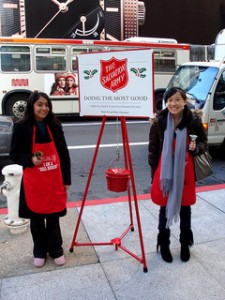Charity and the Beauty Effect
John List and Uri Gneezy have appeared on our blog many times. This guest post is part a series adapted from their new book The Why Axis: Hidden Motives and the Undiscovered Economics of Everyday Life. List appeared in our recent podcast “How to Raise Money Without Killing a Kitten“; the post below offers a fuller description of an experiment discussed in that podcast.
On a chilly Saturday afternoon in December, 2005, Jeanne, a bright, energetic junior at East Carolina University (ECU), trotted up the walk of a suburban home in Pitt County, N.C. Jeanne wore a shirt emblazoned with the name “ECU Natural Hazards Mitigation Research Center.” She also wore a badge with her photograph, name, and solicitation permit number on it. She knocked, and a middle-aged man opened the door.
“Yes?” he said, eyeing her.
“Hi,” she said, smiling brightly. “My name is Jeanne. I’m an ECU student visiting Pitt County households today on behalf of the newly formed ECU Natural Hazards Mitigation Research Center. Would you like to make a contribution today?” It’s probably safe to say that the last thing the middle-aged man had on his mind was the possibility of Jeanne being a double agent. Yes, she was really trying to raise money for the center. But she was also part of a bigger experiment involving dozens of college students knocking on the doors of 5,000 households in Pitt County.
Some of the students just asked for donations with a standard script, but we were interested in finding out what sorts of selfish motivations can influence giving, so another set of solicitors advertised a small incentive in the form of a charitable raffle. If you’ve ever been to a county fair or a big sporting event you’ve probably had the chance to participate in a charitable raffle. It’s pretty simple: the more you give, the higher your chance of winning some big prize. Sometimes the prize is a piece of memorabilia or an exotic beach vacation, but in Pitt County the winner of our charitable raffle received $1,000.
What did we find? Not surprisingly, the raffle-ticket raised roughly 50 percent more in proceeds than the request for donations alone, and doubled the number of people who gave to our cause.
But we also discovered something else that really shouldn’t have surprised us. As it turned out, the more attractive the solicitor, the bigger the donations raised. We had photographs of our solicitors rated for physical attractiveness on a scale of 1 to 10, and we found that someone like Jeanne, who’d been rated an 8, raised about 70 percent more than an equally qualified fundraiser who rated a 6. Perhaps not surprisingly, they enjoyed the greatest fundraising success when a male answered the door.
When it comes to selfish motivations, though, not all incentives are created equal. Years after our first fundraising campaign with ECU, we had another batch of students go around to the same houses in Pitt County and we found that people who gave because of the raffle continued to give years later. Those that gave the first time around just to see a pretty face? They were suddenly much less generous.
It turns out that bribing generosity out of donors isn’t that easy. You have to be careful to pick incentives that suggest your charity is of a high quality, especially if you want donors that give over and over again. These are a few of the insights gained from this set of experiments, conducted with coauthors Craig Landry, Andreas Lange, Michael Price, and Nicholas Rupp.
If you want to explore our world further, take the Why Axis Challenge: visit www.thewhyaxischallenge.com, post a photo of your copy of The Why Axis, and be entered to win prizes, including a meeting with Uri, John and Freakonomics author Steven Levitt!
Be sure to stay tuned for more posts to come, which will give a glimpse into more ‘undiscovered economics.’


Comments